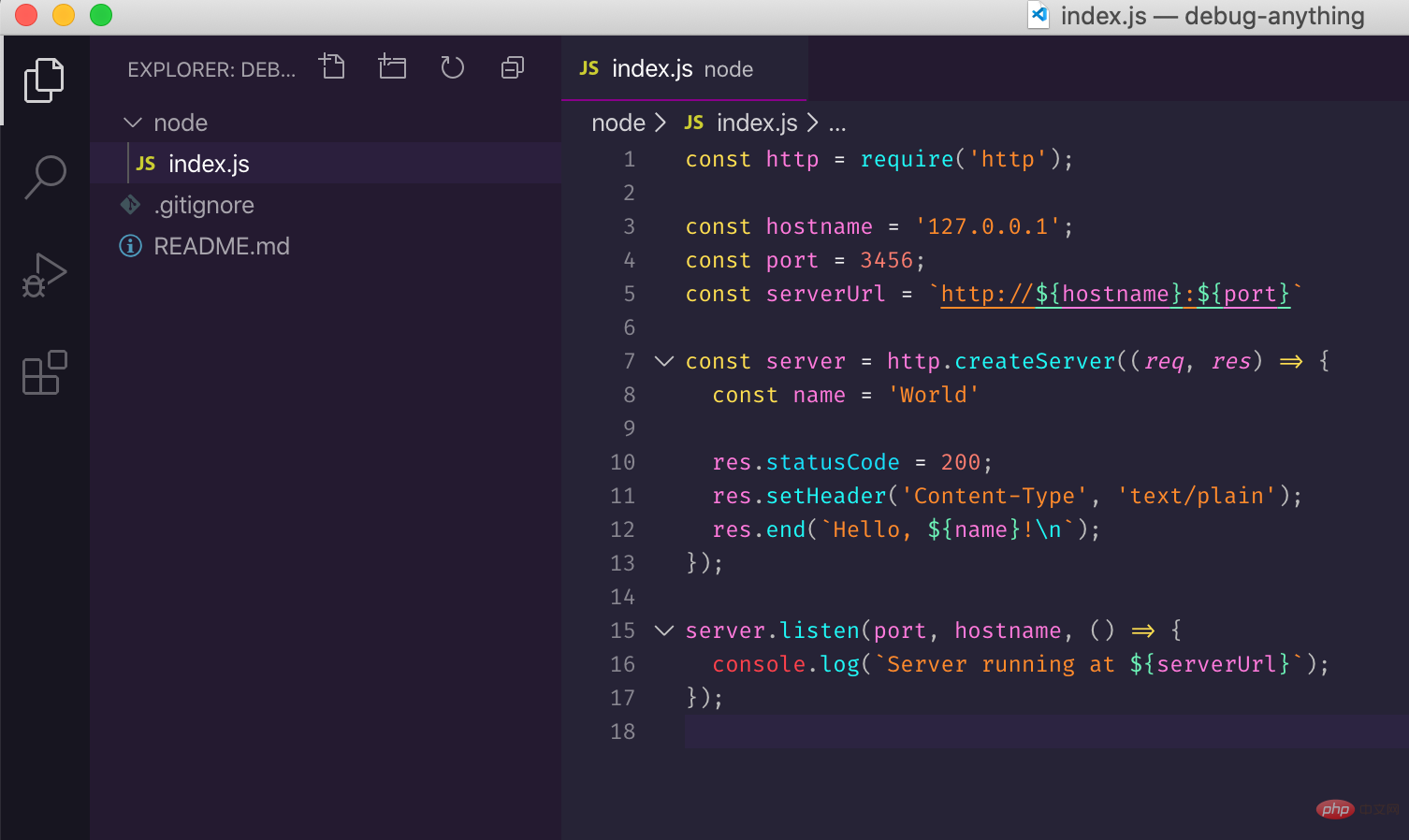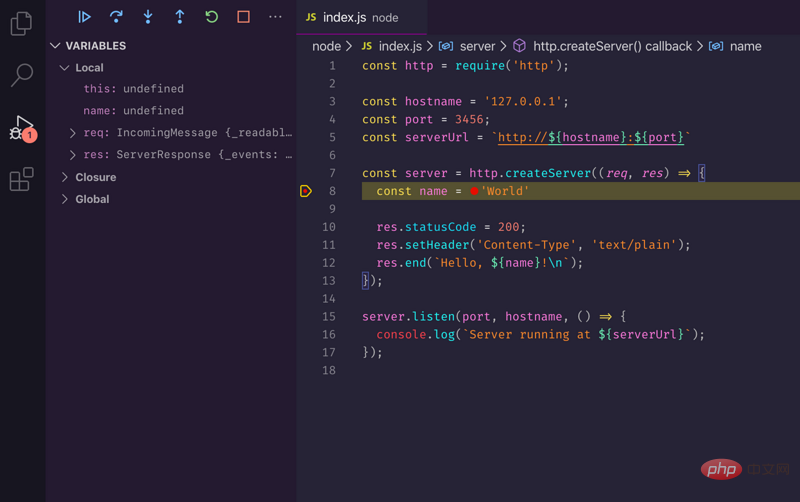VSCode debugging tutorial (1): Understand the basics

In the next few articles, we will look at how to debug JavaScript and TypeScript code in a professional way. Instead of having console.log flying around, we'll learn how to use the debugger built into Visual Studio Code.
The debugger allows you to open a program while it is running, view its status, variables, pause and step through the data flow. You can even run code snippets and try out ideas in the runtime environment. All this without modifying the code (adding console.log!) and restarting after stopping the program. You can use the debugger to solve problems and understand your code faster.
We'll start with some simple Node.js code and then look at debugging browser programs, Express servers, GraphQL, TypeScript, Serverless, Jest tests, Storybooks, and more, but there are a few things to know before that. Necessary basic knowledge! Even if you don't like server-side Node.js, I still hope you read this article first.
Get the code
The code of this series on GitHub: https://github.com/thekarel/debug-anything
The code for our first topic is very simple - first copy and paste the following code into your index.js file:
const http = require('http');
const hostname = '127.0.0.1';
const port = 3456;
const serverUrl = `http://${hostname}:${port}`
const server = http.createServer((req, res) => {
const name = 'World'
res.statusCode = 200;
res.setHeader('Content-Type', 'text/plain');
res.end(`Hello, ${name}!\n`);
});
server.listen(port, hostname, () => {
console.log(`Server running at ${serverUrl}`);
});Now Go ahead and open the folder in VS Code:

To make sure everything is fine, try running this:
node index.js
Then visit http ://127.0.0.1:3456, you should see Hello, World!.
Please make sure to stop the node index.js command immediately, otherwise you will receive an ugly "error: Error: listen EADDRINUSE error soon
The code itself is simple: run an HTTP server and call "Hello, World! ” respond to every request. Pretty simple, right? But this simple code is enough for us to understand the basic concepts of debugging.
Add new features
Let's add a feature to the server: instead of returning a hard-coded message "Hello, World!", we get the name from the query, upon clicking http:// 127.0.0.1:3456/?name=Coco will reply Hello, Coco!.
We pretend not to know what to do first. After running the server, send the request and check Coco Isn't it more fun to show up somewhere? Give it a try. Start the debugger!
Start the debugger
Make sure index.js is open in VS Code, click the debugger icon, click "Run and Debug", then click Node.js:

Now your server is running in debug mode! Visit http://127.0.0.1:3456?name=Coco You will not see any difference and the default message should still be returned.
Next, add a breakpoint(breakpoint) to the code so that execution will be paused the next time the server URL is accessed. This can be done by clicking on the line number to the left of the editor:

Visit http://127.0.0.1:3456?name=Coco, VS Code will pop up a view and pause the server:

We need to first find out the position of name in the query so that we can complete the subsequent work. In the left sidebar: you will see a file namedVariables section. Under Local, the IDE displays all variables in the local scope of the function. There is one that looks very likely: req:

Now we know that the request query string is located in req.url, With the help of the documentation, we modify the code script For:
const http = require('http');
const url = require('url');
const hostname = '127.0.0.1';
const port = 3456;
const serverUrl = `http://${hostname}:${port}`
const server = http.createServer((req, res) => {
const {name} = url.parse(req.url, true).query;
res.statusCode = 200;
res.setHeader('Content-Type', 'text/plain');
res.end(`Hello, ${name}!\n`);
});
server.listen(port, hostname, () => {
console.log(`Server running at ${serverUrl}`);
}); Since the code has been modified, the server needs to be restarted. Using the debugger is easy: you can press  or click the green restart icon:
or click the green restart icon:

You can also disable breakpoints as it is no longer needed:

Visit http://127.0.0.1:3456?name =Coco, look at the results of our work!
Hope you can continue to explore the debugger. In the next article, we will use the "step over", "step in" and "step out" functions to debug the code line by line.
VSCode debugging tutorial series:
English original address: https ://charlesagile.com/debug-series-nodejs-browser-javascript
Author: Charles Szilagyi
This article is reproduced from: https://segmentfault.com/a/1190000022764213
Recommended related tutorials: vscode introductory tutorial
The above is the detailed content of VSCode debugging tutorial (1): Understand the basics. For more information, please follow other related articles on the PHP Chinese website!

Hot AI Tools

Undresser.AI Undress
AI-powered app for creating realistic nude photos

AI Clothes Remover
Online AI tool for removing clothes from photos.

Undress AI Tool
Undress images for free

Clothoff.io
AI clothes remover

Video Face Swap
Swap faces in any video effortlessly with our completely free AI face swap tool!

Hot Article

Hot Tools

Notepad++7.3.1
Easy-to-use and free code editor

SublimeText3 Chinese version
Chinese version, very easy to use

Zend Studio 13.0.1
Powerful PHP integrated development environment

Dreamweaver CS6
Visual web development tools

SublimeText3 Mac version
God-level code editing software (SublimeText3)

Hot Topics
 1655
1655
 14
14
 1414
1414
 52
52
 1307
1307
 25
25
 1254
1254
 29
29
 1228
1228
 24
24
 What computer configuration is required for vscode
Apr 15, 2025 pm 09:48 PM
What computer configuration is required for vscode
Apr 15, 2025 pm 09:48 PM
VS Code system requirements: Operating system: Windows 10 and above, macOS 10.12 and above, Linux distribution processor: minimum 1.6 GHz, recommended 2.0 GHz and above memory: minimum 512 MB, recommended 4 GB and above storage space: minimum 250 MB, recommended 1 GB and above other requirements: stable network connection, Xorg/Wayland (Linux)
 How to define header files for vscode
Apr 15, 2025 pm 09:09 PM
How to define header files for vscode
Apr 15, 2025 pm 09:09 PM
How to define header files using Visual Studio Code? Create a header file and declare symbols in the header file using the .h or .hpp suffix name (such as classes, functions, variables) Compile the program using the #include directive to include the header file in the source file. The header file will be included and the declared symbols are available.
 vscode terminal usage tutorial
Apr 15, 2025 pm 10:09 PM
vscode terminal usage tutorial
Apr 15, 2025 pm 10:09 PM
vscode built-in terminal is a development tool that allows running commands and scripts within the editor to simplify the development process. How to use vscode terminal: Open the terminal with the shortcut key (Ctrl/Cmd). Enter a command or run the script. Use hotkeys (such as Ctrl L to clear the terminal). Change the working directory (such as the cd command). Advanced features include debug mode, automatic code snippet completion, and interactive command history.
 Where to write code in vscode
Apr 15, 2025 pm 09:54 PM
Where to write code in vscode
Apr 15, 2025 pm 09:54 PM
Writing code in Visual Studio Code (VSCode) is simple and easy to use. Just install VSCode, create a project, select a language, create a file, write code, save and run it. The advantages of VSCode include cross-platform, free and open source, powerful features, rich extensions, and lightweight and fast.
 How to solve the problem of vscode Chinese annotations becoming question marks
Apr 15, 2025 pm 11:36 PM
How to solve the problem of vscode Chinese annotations becoming question marks
Apr 15, 2025 pm 11:36 PM
How to solve the problem that Chinese comments in Visual Studio Code become question marks: Check the file encoding and make sure it is "UTF-8 without BOM". Change the font to a font that supports Chinese characters, such as "Song Style" or "Microsoft Yahei". Reinstall the font. Enable Unicode support. Upgrade VSCode, restart the computer, and recreate the source file.
 Common commands for vscode terminal
Apr 15, 2025 pm 10:06 PM
Common commands for vscode terminal
Apr 15, 2025 pm 10:06 PM
Common commands for VS Code terminals include: Clear the terminal screen (clear), list the current directory file (ls), change the current working directory (cd), print the current working directory path (pwd), create a new directory (mkdir), delete empty directory (rmdir), create a new file (touch) delete a file or directory (rm), copy a file or directory (cp), move or rename a file or directory (mv) display file content (cat) view file content and scroll (less) view file content only scroll down (more) display the first few lines of the file (head)
 vscode terminal command cannot be used
Apr 15, 2025 pm 10:03 PM
vscode terminal command cannot be used
Apr 15, 2025 pm 10:03 PM
Causes and solutions for the VS Code terminal commands not available: The necessary tools are not installed (Windows: WSL; macOS: Xcode command line tools) Path configuration is wrong (add executable files to PATH environment variables) Permission issues (run VS Code as administrator) Firewall or proxy restrictions (check settings, unrestrictions) Terminal settings are incorrect (enable use of external terminals) VS Code installation is corrupt (reinstall or update) Terminal configuration is incompatible (try different terminal types or commands) Specific environment variables are missing (set necessary environment variables)
 vscode Previous Next Shortcut Key
Apr 15, 2025 pm 10:51 PM
vscode Previous Next Shortcut Key
Apr 15, 2025 pm 10:51 PM
VS Code One-step/Next step shortcut key usage: One-step (backward): Windows/Linux: Ctrl ←; macOS: Cmd ←Next step (forward): Windows/Linux: Ctrl →; macOS: Cmd →




